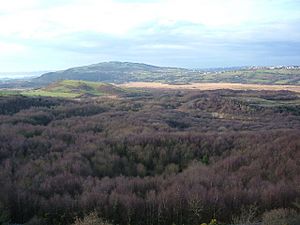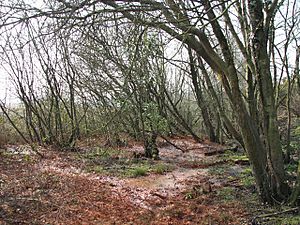Crymlyn Bog facts for kids
Quick facts for kids
Designations
|
|
| Official name: Crymlyn Bog | |
| Designated: | 8 June 1993 |
|---|---|
| Reference #: | 608 |
Crymlyn Bog (Welsh: Cors Crymlyn) is a very special nature reserve. It is found near Swansea, in south Wales. This bog is so important that it has been given an international award. It is known as a Site of Special Scientific Interest.
This amazing place is the largest area of lowland fen in all of Wales. It sits just east of Kilvey Hill. The bog is also north of the industrial area of Crymlyn Burrows.
Contents
Amazing Plants and Habitats
The plants you find in Crymlyn Bog are often seen in places like East Anglia. This is a region far away in England! The bog has many different types of habitats. These include wet swamps and carr (fen) areas. You can also find water meadows and tall reed beds. There are also areas of wet scrub with lots of willow trees.
Some plants in this wetland are very rare in Great Britain. For example, you might spot the slender cotton grass. Another rare plant is the lesser water plantain.
Cool Creatures: The Fen Raft Spider
In 2003, experts studied Crymlyn Bog and nearby wetlands. They found something very exciting! Crymlyn Bog is one of only three places in the whole UK where the fen raft spider lives. We don't know exactly how many spiders there are. But the bog is a great home for them. This means the spider population is likely healthy and stable.
Birds, Birds, Birds!
Crymlyn Bog is a safe place for many different birds. You might see birds of prey like the hen harrier or a buzzard. The speedy hobby also visits regularly. Sometimes, a marsh harrier flies by too.
The bog is a vital home for many wetland birds. Look or listen for the bittern and the water rail. You might also hear sedge and reed warblers singing. The cute bearded tit and the tall grey heron are often seen here.
There is a visitor centre at the bog. Many people who love nature come here. It's a great spot for bird watching too!
A Look Back in Time
Crymlyn Bog has a long history. Long ago, rivers flowed through this valley. The bog also marked an old boundary line. It was between 'South' and 'West Wales'.
Over time, the land around the bog changed. Factories and homes grew up nearby. Some parts of the bog were even used for waste. This caused problems for the plants and animals living there.
But people cared about Crymlyn Bog. A person named Andrew Lees helped protect it. He worked with a group called Friends of the Earth. They started a campaign to save the bog. On one side of the bog, there is a memorial to Mr. Lees. It has a famous quote from him: "At some point I had to stand up and be counted. Who speaks for the butterflies?" Thanks to people like Andrew, Crymlyn Bog is now a protected and thriving nature reserve.




